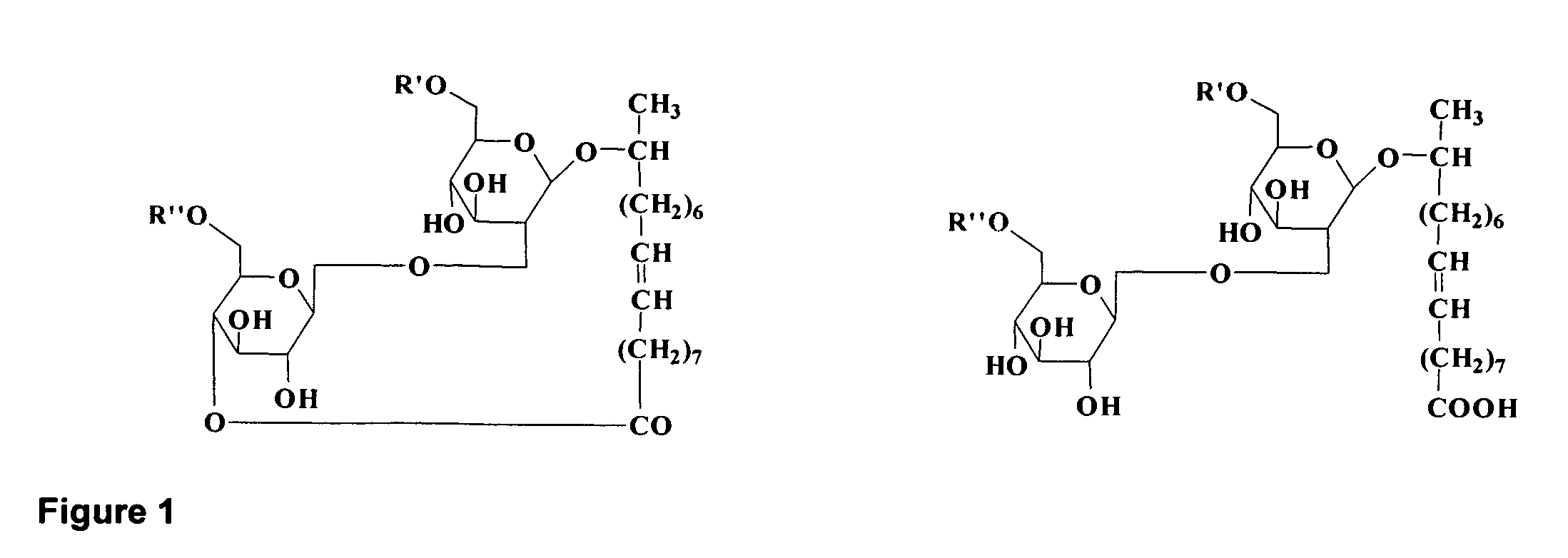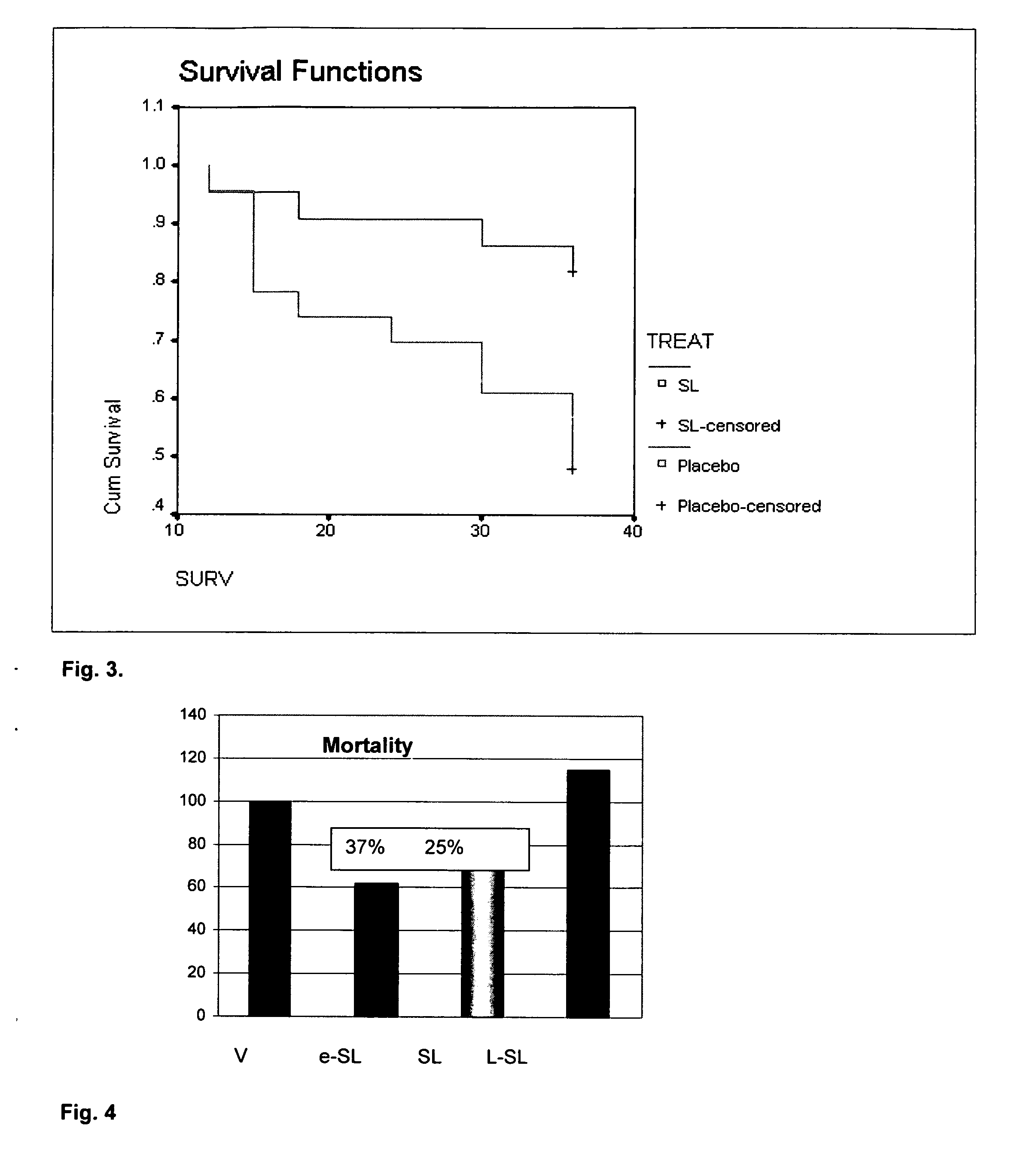Purified Ethyl Ester Sophorolipid for the Treatment of Sepsis
a technology of ethyl ester and sophorolipid, which is applied in the field of production of ethyl ester sophorolipid derivatives, can solve the problems of labor-intensive and costly silica gel column chromatography, and it is difficult to assign biological activity to a specific pharmacophore, etc., and achieves the effects of high purity, labor-intensive and costly, and efficient production of sophorolipids
- Summary
- Abstract
- Description
- Claims
- Application Information
AI Technical Summary
Benefits of technology
Problems solved by technology
Method used
Image
Examples
example 1
[0051]Preparation of natural sophorolipid mixture. A single colony of Candida bonibicola ATCC 22214 cultured on GY medium in agar is cultured in 50 milliliter shake flasks in liquid GY medium at 30 C for 24 hours. This starter culture is then aseptically harvested and transferred to a 1 liter working volume stirred tank fermentor which is set to 30 C at 400 RPM and aerated at 0.8V / min. After 24 hours growth 40 grams of sterile glucose (as a 50 wt % solution) is added to the fermentor followed by 40 grams of sterile oleic acid and the culture. After 24 hours the fermentor is charged with an additional 20 grams of sterile glucose. A final 20 grams of sterile glucose is added to the fermentor after 24 hours which is followed by 24 hours of cultivation. The fermentation is stopped and the crude sophorolipid product is allowed to settle to the bottom of the reactor which is then separated by decanting the spend culture broth to afford a viscous light brown syrup. The syrup is washed with...
example 2
[0052]Preparation of Ethyl-17-L-[(2′-O-D-glucopyranosyl-D-glucopyranosyl)-oxy]-cis-9-octadecenoate. To a round bottom flask is added 1 gram (1.6 mmol) of dried sophorolipid free acid followed by 10 milliliters of dry ethanol freshly distilled from magnesium turnings. The reaction mixture is stirred under nitrogen and charged with 20 milligrams (0.29 mmol) of sodium ethoxide powder. The reaction mixture is heated to reflux and stopped by cooling after being judged complete by the disappearance of starting material by TLC. The cooled in an ice bath and the solution is neutralized by addition of glacial acetic acid and then the solvent was removed under vacuum to afford a light yellow oil. The oil was dispersed in cold water and the ethyl ester sphorolipid was recovered as a white powder by filtration.
[0053]Since the previous version of this application, we have confirmed that sophorolipids as Glyco 23 formulation have no significant antibiotic activity at clinically relevant concentra...
example 3
[0054]Effect of Glyco 23 on mortality in intra-abdominal sepsis. Preliminary data to develop a CLP model for these studies showed that we can obtain reproducible mortality rates of 60% to 70% with a 16 gauge needle in a CLP model. The CLP model was chosen for its reproducible mortality rates and its ability to mimic fecal peritonitis.
[0055]Animals were randomized into two groups: control and experimental, (n=25 / group) as shown in FIG. 3 induced with septic peritonitis via CLP; and treated IV with saline or natural sophorolipid mixture (SL) (5 mg / kg). This dose is well below the LD50 (6-7 gm / kg) of naturally occurring sophorolipids in rodents.(40,41). Doses were given at the end of the surgery, and animals were followed for 36 hours. Kaplan Meier statistics were performed on survival. The 36 hr survival rate was 47.8%, and increased to 81.8% in animals treated with sophorolipid IV (P<0.05) (FIG. 3). This significant improvement in survival was achieved with a single dose of natural s...
PUM
| Property | Measurement | Unit |
|---|---|---|
| Temperature | aaaaa | aaaaa |
| Temperature | aaaaa | aaaaa |
| Weight | aaaaa | aaaaa |
Abstract
Description
Claims
Application Information
 Login to View More
Login to View More - R&D
- Intellectual Property
- Life Sciences
- Materials
- Tech Scout
- Unparalleled Data Quality
- Higher Quality Content
- 60% Fewer Hallucinations
Browse by: Latest US Patents, China's latest patents, Technical Efficacy Thesaurus, Application Domain, Technology Topic, Popular Technical Reports.
© 2025 PatSnap. All rights reserved.Legal|Privacy policy|Modern Slavery Act Transparency Statement|Sitemap|About US| Contact US: help@patsnap.com



